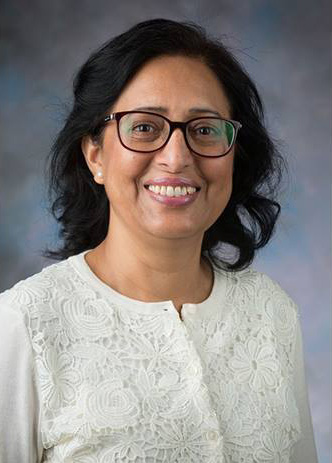
Sign up for a new account.
And get access to
The latest T1D content
Research that matters
Our daily questions
Sign up by entering your info below.
Reset Your Password
Don't worry.
We will email you instructions to reset your
password.
Manmohan “Manu” Kamboj, MD, is a pediatric endocrinologist, division chief of Endocrinology at Nationwide Children’s Hospital, a professor of pediatrics at The Ohio State University College of Medicine, and is an accomplished academician, clinician, and teacher.
In addition, Dr. Kamboj is co-chair of the QIC Clinical Leadership Committee. She has held administrative roles and served on various committees for the Pediatric Endocrine Society. Her clinical interests include diabetes, long-term endocrine follow-up of bone marrow transplant patients, Prader-Willi syndrome, and polycystic ovarian syndrome.
Interview with Dr. Manmohan Kamboj
In this interview, Kamboj discusses her expertise in supporting people with type 1 diabetes (T1D) and working to improve patient care through the T1D Exchange Quality Improvement Collaborative (T1DX-QI).
The T1DX-QI was established in 2016 — with the support of The Leona M. and Harry B. Helmsley Charitable Trust — in an effort to refine best practices and improve daily life for people with type 1 diabetes (T1D). Growth has been tremendous, with 54 endocrine clinics from across the U.S. participating in the Collaborative.
Fueled by top leaders in diabetes care, the T1DX-QI has become an engine of innovation and inspiration. By engaging with the shared, data-driven, and systematic methods of the T1DX-QI, clinics have seen unprecedented success in their approach to diabetes management.
With members working closely together to identify gaps in care, discover and refine best practices, and share research — the process has become knowledge-sharing at its very best. While collated data gives clinics a clear sense of “where they are,” it also demonstrates “where they can be” by applying shared, evidence-based methods for improving care.
The complexity of endocrinology
“Endocrinology is a complex and interesting sub-specialty,” said Dr. Kamboj. “It’s extremely rewarding to take care of children with chronic endocrine issues.”
As one of the founding members of the QIC, Dr. Kamboj stated, “Nationwide Children’s is deeply vested and embedded in the QIC and loves the collaboration.” She credits collaboration with her peers for the measured quality improvements underway in T1D patient care. “The ultimate aim of the collaborative is to become a collective voice that can speak to evidence-based learning. It can equip us all to advocate for our T1D patients and families, so that we can better address their needs,” explained Dr. Kamboj.
“The collaborative has a repository of collected data, helping to inform evidence-based practice. This can help on a national — and even international scale — with patient advocacy and improved clinical outcomes,” explained Dr. Kamboj.
“Nationwide is the largest, free-standing children’s hospital with an institutional leadership focus on QI. I believe that our participation in the QIC has been mutually beneficial,” stated Dr. Kamboj who serves as the PI and director of QI for the endocrinology division at Nationwide. “While we
collaborate, we have done really well institutionally and brought positive recognition to our institution and our division,” which includes a strong endocrinology fellowship program.
Improving CGM use in children with T1D
“We have a robust QI team in Endocrinology,” explained Dr. Kamboj. “I think our team’s work on continuous glucose monitoring (CGM) has been exceptionally remarkable.”
Dr. Kamboj described how their QI team engaged their entire diabetes team in a QI initiative to improve CGM use — and the outcomes were impressive. “We made an aim to increase from 8% to 20% over the first year, but we ended up with a 40% increase instead. Now, three years later, we’re over 65%, and on this journey, we’ve become an example for so many others.”
The Collaborative has been the perfect outlet for sharing their steps to success. Dr. Kamboj shared, “We went to the state legislature to advocate for CGM use and to remove some restrictions attached to approval. We made process improvements and efficiencies by auto-populating a letter of medical necessity into our EHR. CGM uptake and use was promoted by all diabetes team members at every clinic visit by dedicating at least 2- 3 minutes of appointment time to promote CGM and identify barriers.”
Dr. Kamboj went on to explain, “I believe that as soon as a child is diagnosed with T1D they should get a CGM device — we are not there yet. Hopefully, we’ll be able to overcome insurance and other barriers to achieve this aim. I believe that CGM is one of the best things that have happened in diabetes care — aside from the insulins, of course!” explained Dr. Kamboj.
Addressing health inequities
That being said, the Collaborative members do recognize the presence of health inequities, and the difficulties individuals living with T1D may face in relation to them. Dr. Kamboj is engaged with a QIC special project that’s examining social determinants of health, and ways to improve equity and access to patient-centered care.
She explained, “Inequities are everywhere in the world, in every aspect of life, and in medicine. As a collective voice, the collaborative is interested in improving care and decreasing inequities. We’re learning more about social determinants of health, how to improve inequities, and provide access to patient-centered care and diabetes technologies.”
In her spare time, Manu enjoys traveling and exploring new places with her husband, cooking for friends and family, and spending time with her two adult children — both of whom are pursuing residency training programs.
Jewels Doskicz
Related Stories
1 Comment
Meet the Expert: Increasing CGM Usage & Streamlining Processes Cancel reply
You must be logged in to post a comment.









I’m a physician on Medicare in California with T1D. Byram has not been dependable for supplying infusion and CGM supplies. What companies have the best track records for providing DM supplies?